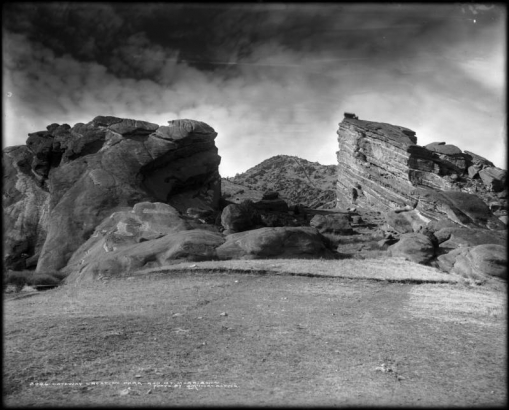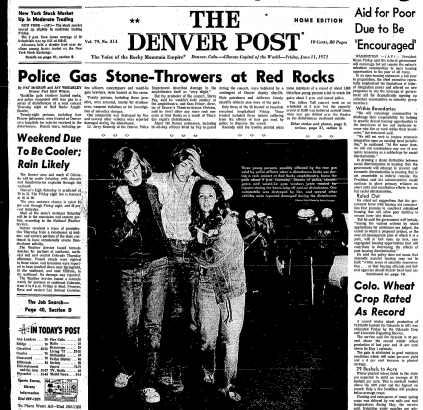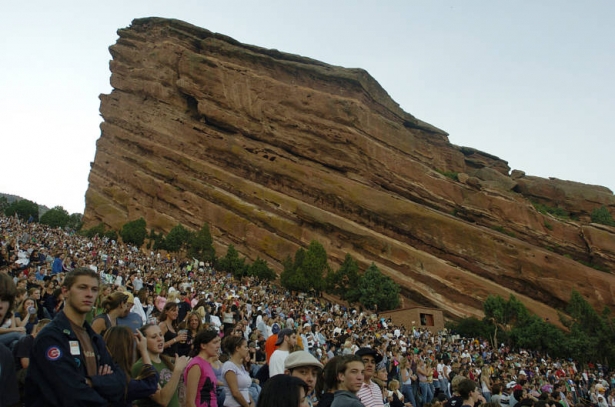On June 10, 1971, a large group of rock fans attempted to bum-rush the gates at Red Rocks Amphitheatre in an effort to see the band Jethro Tull.
In the aftermath of that event, the City of Denver imposed a ban on all "rock" shows at the venue, which didn't turn out quite how the City (mainly Mayor Bill McNichols) planned.
In fact, the city's rock ban actually wound up spurring on one of the most successful concert series of all time and catapulted Red Rocks into the realm of concert venue legend.
They Came from the Hills
If you're having trouble imagining how a Jethro Tull concert could turn into a riot, it might be a case of, "You had to be there to understand." In the late 1960s and early 1970s, plenty of young people felt as though music was an entity that shouldn't be commercialized. They were also not above using the full force of youth to rush into concerts, as was evidenced at the legendary Woodstock Festival.
That dynamic was in full effect at Red Rocks that night when thousands of fans who hadn't purchased tickets congregated in the hills surrounding Red Rocks to catch a free listen to the long sold-out show. The trouble began when the "hill people" decided that they should just go ahead and force their way into the amphitheater.
This did not go down well with the Denver Police Department, who have long held jurisdiction at Red Rocks on concert days.
What happened next was recounted by Chris Van Ness in the June 18, 1971, edition of the Los Angeles Free Press:
The police, feeling that it would be impossible to maintain security in any other way due to the rough terrain, began dropping tear gas out of helicopters which were flying a dangerously low watch over the crowds.
Rather than acting as a deterrent, the tear gas seemed to spur the now-rioters on to further acts of violence As more tear gas began to fill the amphitheater at an alarming rate, the gate-crashers and audience alike began to pick up bottles and rocks to use as ammunition against the police. One car was overturned and burned, and many people suffered injuries ranging from broken bones to gas inhalation.
Not only did the tear gas not quell the riots, it made its way to the stage at the base of the natural amphitheater. The scene could only be described as bedlam, and it had the potential to be a lot worse.
Welcome to World War 3
Backstage at Red Rocks, Barry Fey and the members of Jethro Tull were faced with a conundrum. They could cancel the show and send the paid audience straight into a riot, or they could play the show as planned.
To their everlasting credit, the members of Jethro Tull decided to go on with the show. Jethro Tull lead singer Ian Anderson took to the stage with guitar in hand and greeted the audience saying, "Welcome to World War Three!" And with a full-scale riot playing out in the hills surrounding them, and clouds of tear gas wafting onto the stage, Jethro Tull proceeded to play their full set.
The band's commitment to playing on earned them praise from both the Denver Police Department and Fey, who praised the band in the Los Angeles Free Press saying, "God bless those guys. They're the most professional group I've ever worked with. I don't know anybody else that would have stayed on through all that."
Rock 'n' Roll Aftermath
Reaction to the events at Red Rocks that night came swiftly from Denver Mayor Bill McNichols. The very next day, the mayor swiftly imposed a ban on all rock shows at Red Rocks saying:
As long as I'm mayor, this city is not going to be turned over to rock-throwing hoodlums. If they think they're going to be allowed to run free, attacking innocent people and police officers, they have another guess coming.
McNichols was hardly alone in his view on the future of rock 'n' roll at Red Rocks. Caught up in the moment, a clearly frustrated Fey said that he was done promoting rock shows at Red Rocks. In an interview with the Denver Post on June 11, he said, "If they (the rock artists) want to come into the (Denver) Coliseum (instead of Red Rocks), we'll do it. But most of them know of Red Rocks and wanted to play there."
Though Fey would ultimately change his tune regarding Red Rocks, Sam Feiner, the director of the city Theatres-Arenas Division, was firm in his stance that Red Rocks's time as a rock venue had, "definitely ended." To that end, upcoming shows by hard rock heroes Poco, Chicago, and Stephen Stills were canceled.
The Blame Game
In the aftermath of the riot, there was plenty of blame to go around. While the Denver Police were accused of overreacting to the situation by dropping tear gas, most of the blame was rightly aimed at the gate-crashing rioters.
At the Los Angeles Free Press, Van Ness said, "When it comes to placing blame for the events of last Thursday evening, it must rest with the kids who tried to crash the gate. But the rest of the chemistry is an all-too-familiar formula. The police reacted with fear and stupidity."
At the Rocky Mountain News, music critic Thomas MacCluskey pulled no punches in a column titled, "Rock Rowdies Ruin it for Everyone." MacCluskey pointed out that this was hardly the first time that Denver music fans had acted up.
He recalled that in August 1968, a riot had broken out at an Aretha Franklin show at Red Rocks after the legendary performer told the crowd that she would not be playing because she hadn't been paid. That resulted in a one-year ban on rock shows.
MacCluskey used that as a jumping-off point to school an entire generation for its entitled behavior. "Yes, you 'get-something-for-nothing' generation—in fact, 'get-everything-for-nothing' fools—you caused a one-year ban on rock concerts then...You're just too cute for words."
The angry critic went on to predict that there wouldn't be any rock shows at Red Rocks, "...until your little brothers and sisters come along and realize that what you're trying to do is an utter impossibility. There is no 'something-for-nothing' in this universe."
MacCluskey was right, for a few years anyway.
Barry Fey vs. The Man
Mayor McNichols was not kidding when he said that rock shows at Red Rocks were a non-starter, as the 1972 Red Rocks schedule neatly illustrates. That summer's lineup did not rock, even a little bit. Artists on the bill that year included Joan Baez, Pat Boone and the Carpenters.
And that's the way it was, right up until Fey took the City to court and won the right to once again book rock acts at Red Rocks. With a dash of typical Fey flair and marketing finesse, the legendary promoter christened the now-familiar, "Summer of Stars" series in 1976.
The Bicentennial summer's lineup was considerably more dynamic than it had been in 1971-1975. Acts on the bill included Neil Young, Stephen Stills, David Crosby, Willie Nelson and the Average White Band. (Remember to view these bands through the lens of 1976, when acts like this represented mainstream rock 'n' roll and were considered to be somewhat anti-establishment.)
That summer launched Red Rocks into the stratosphere and as the Summer of Stars established itself, Red Rocks became America's premiere outdoor music venue.
Red Rocks Forever
From U2's iconic "Under a Blood Red Sky" performance in 1983 to dozens of sold-out nights with the Grateful Dead, and a list of artists that's too long to mention (but is conveniently listed on the Red Rocks' Concert Archive), Red Rocks has offered something for everyone.
What's more, an evening at Red Rocks is always tinged with Colorado's natural beauty—the twinkling city lights serving as an almost magical backdrop to the music coming from the stage.
Red Rocks is also a favorite spot for artists and plenty of aspiring artists have it on their bucket lists.
The memorable amphitheater is so far ahead of the curve that Pollstar Magazine, a trade journal for the concert industry, awarded Red Rocks it's Best Outdoor Venue Award 11 years in a row. To give other outdoor venues a chance, Pollstar went ahead and changed the name of the accolade to the Red Rocks Award in 2001 and took Red Rocks out of the running entirely.
Of course, anyone who has ever attended a show (or graduation or church service or film) at Red Rocks knows what a special place it is and how much it means to the people of Denver. And while there have been plenty of rock shows at Red Rocks since the ban was lifted, there hasn't been anything quite like the night Jethro Tull fans almost ruined Red Rocks for everyone.
What's your favorite Red Rocks memory? Share it in the comments section below or on the Western History & Genealogy Facebook Page.





Comments
My favorite Red Rocks memory
My favorite Red Rocks memory also involves The Police - the 80's band not law enforcement. The Police played 2 shows at Red Rocks during their reunion tour in 2008. The friend of a friend got me backstage during a soundcheck. I met Sting, Stewart Copeland and Andy Summers. That was a good day.
Shelby, that really does
Shelby, that really does sound like a good day, even by the pretty high standards that Red Rocks sets up on any given day! Thanks for sharing that with us.
I was at that Jethro Tull
I was at that Jethro Tull concert. My memory is that the police were dropping the tear gas at the back of the amphitheater and the wind blew it all the way down to the stage. The show stopped a couple of times, once when opening act Livingston Taylor (James' brother) was performing, causing him to leave the stage early; and once when Tull was playing. I was sitting about halfway up from the stage and had to use my jacket as a face mask to breathe through to keep from feeling the effects of the gas. Ian Anderson said in a Rolling Stone interview that summer that the police wanted to cancel the show but he pleaded with then to let Tull perform, otherwise there would be an even bigger riot. But despite it all I thought it was a great show. Another rock show riot before this was at Mile Stadium during the Denver Pop Festival in 1969. They had to evacuate Jimi Hendrix from the stage in a moving truck to avoid the melee on the infield.
On a more tranquil note, my high school graduation was held at Red Rocks. I was in the school band, so I like to tell people that I've performed at Red Rocks.
Jimi's show was hardly a
Jimi's show was hardly a melee he had to be "evacuated" from. I was at stage right a few feet from Jimi and Noel had quit playing, dropping his bass, he quit the band that night. Then Mitch stopped while Jimi kept playing. Three guys came out and took him offstage and I was standing by those steps at that time as they tossed Jimi into the back of the truck.
You can read the story in Univibes "Jimi Plays Denver" issue where I am interviewed about it. It was reprinted in Experience Hendrix magazine May/June 1999 also. It is also in the wayback machine website.
Hi Bob - Thanks for the
Hi Bob - Thanks for the firsthand account of that night - primary sources are golden in our business!. Also, had no idea that was Noel Redding's last show with Jimi.
Great article, thanks Brian!!
Great article, thanks Brian!!
Thank you, Brooke!
Thank you, Brooke!
Hi Jude - Thanks for the
Hi Jude - Thanks for the first hand account. The research I did definitely jibes with that account with DPD dropping gas from helicopters and the gas just making its way down the amphitheater. All the accounts I read praised Anderson, and the rest of the band, for not high tailing out of Denver and performing under pretty difficult circumstances.
Thanks again for sharing your first hand account (in this business we call that a primary source and it's really the gold standard of research!).
No Red Rocks memories,
No Red Rocks memories, similar to the Red Rocks and Mile High Stadium riots: 1. Chicago summer of '70, riot at a free Sly Stone concert at Grant Park . Rock concerts banned from Grant Park within a week.
2. Ravinia, north suburban Chi. area summer of '70, unrest as many sneak into a Janis Joplin concert. Ravinia doesn't ban rock.
3. Albuquerque '77-78, vandalism at a Jimmy Buffet concert. Rock banned from this city owned venue.
What other cities had similar disturbances and how did city government react ?
Those were turbulent times to
Those were turbulent times to be certain! Thanks for sharing your memories with us!
Add new comment